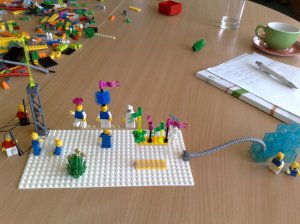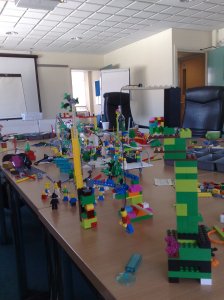Last week I was lucky enough to go on a session about using Lego as a means of facilitating creativity and/or strategy. It wasn’t the full ‘Lego Serious Play‘ experience – but it piqued my curiosity in this and was interesting so I thought I’d share – and share some fun photos I took of the serious play we were enganged in. Serious Play is a technique that Lego have developed for using their bricks, etc in the office for, erm, work.
The session I went to was run by the Digital Research Unit based in Huddersfield.
The idea is that using the bricks can help people use their imaginations and using the bricks to express complex ideas and relationships in 3D, describe complicated relationships and also give you a chance to use your hands (which, in theory, helps some people engage their brains more). They can also be used in brainstorming – and many of you saw an example of how this can be done in an exercise one of my colleagues ran a few months ago.
We worked through a process where we used the Lego to model our own role; then how we operate within that role; the wider organisation etc, until we built up a large model of how our roles fit together and fit into the BBC. We also built aspects of ourself that we don’t bring to work and used these to do some introspection into how we might (or might not) change the way we operated, etc.
The main idea was to get people to work through their individual identity, then team identity and then the wider environment/landscape their role and organisation exists in.

My role - in Lego!

How I operate in my role - In Lego!

A 'model' BBC
I was really captivated by how much the Lego opened up the conversations we were having. ‘Playing’ allowed us to put alot of our normal conversational conventions to the side and forced us to explain things in a simple way that wasn’t offensive or overly formal because we were using simple tools for explaining our ideas. I also thought about people I work with who aren’t necessarily comfortable expressing themselves verybally who could use this as a means of showing instead of speaking. And, best of all, building something before you explain it makes you think before you speak; and let’s face it, we could all do more of this.
Effectively we were building stories. Stories about who we are, where we work and how we do it. But this storytelling could be expanded to help build stories for use in programme making or other content. I recently read an article in Wallpaper* (which unfortunately isn’t online) about how architects are building stories and fantasy into some of the new work that’s being done in that field because they’re trying to embrace our contemporary need for more narrative experiences that blur the difference between real and fantastic.
I think this is especially important when you work with digital media – sure everything needs to be functional and simple – but it should also delight and building this delight is the hardest part. Sure Google search is a wonderful piece of technology, but it latched into not being ‘just another search box’ by having fun and playing with its logo. I’d hope that in the type of work that I do, that if we start by expressing our ideas with Lego (or other manual tools for that matter) that we might capture some of the fun and fantasy that can get lost along the way.
We’ll see how it goes. I’ve just installed a few containers full of Lego in meeting spaces for my team to ‘play’ with…
Some more info on Lego in the office/work environment:
http://www.artlab.org.uk/lego.htm
http://kn.theiet.org/magazine/issues/0903/lego-for-life-0903.cfm
